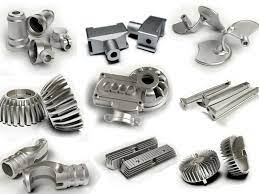Aluminium alloys versus types of steel
Aluminium alloys typically have an elastic modulus of about 70 GPa, which is about one-third of the elastic modulus of steel alloys. Therefore, for a given load, a component or unit made of an aluminium alloy will experience a greater deformation in the elastic regime than a steel part of identical size and shape.

With completely new metal products, the design choices are often governed by the choice of manufacturing technology. Extrusions are particularly important in this regard, owing to the ease with which aluminium alloys, particularly the Al–Mg–Si series, can be extruded to form complex profiles.

In general, stiffer and lighter designs can be achieved with Aluminium alloy than is feasible with steels. For instance, consider the bending of a thin-walled tube: the second moment of area is inversely related to the stress in the tube wall, i.e. stresses are lower for larger values. The second moment of area is proportional to the cube of the radius times the wall thickness, thus increasing the radius (and weight) by 26% will lead to a halving of the wall stress. For this reason, bicycle frames made of aluminium alloys make use of larger tube diameters than steel or titanium in order to yield the desired stiffness and strength. In automotive engineering, cars made of aluminium alloys employ space frames made of extruded profiles to ensure rigidity. This represents a radical change from the common approach for current steel car design, which depend on the body shells for stiffness, known as unibody design.
Aluminium alloys are widely used in automotive engines, particularly in cylinder blocks and crankcases due to the weight savings that are possible. Since aluminium alloys are susceptible to warping at elevated temperatures, the cooling system of such engines is critical. Manufacturing techniques and metallurgical advancements have also been instrumental for the successful application in automotive engines. In the 1960s, the aluminium cylinder heads of the Corvair earned a reputation for failure and stripping of threads, which is not seen in current aluminium cylinder heads.

An important structural limitation of aluminium alloys is their lower fatigue strength compared to steel. In controlled laboratory conditions, steels display a fatigue limit, which is the stress amplitude below which no failures occur – the metal does not continue to weaken with extended stress cycles. Aluminium alloys do not have this lower fatigue limit and will continue to weaken with continued stress cycles. Aluminium alloys are therefore sparsely used in parts that require high fatigue strength in the high cycle regime (more than 107 stress cycles).
